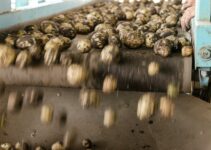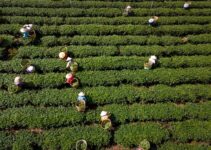I've learned a lot about maximizing THC profits from hemp cultivation, and I'm excited to share these six best tips with you. From soil preparation to strategic harvesting techniques, these methods have helped me boost my yields and quality. Whether you're a seasoned grower or just starting out, implementing these strategies can make a significant impact on your hemp cultivation success. Keep reading to learn how to optimize your hemp production for maximum THC profits.
Key Takeaways
- Conduct thorough soil testing and nutrient management to optimize THC yields
- Select hemp strains with high THC content and consider genetics for enhanced THC production
- Maintain ideal growing conditions and soil requirements for robust hemp cultivation
- Prioritize efficient water management and implement pest and disease control measures for healthy plant growth and maximum THC profits
Soil Preparation
I'm preparing the soil for hemp cultivation by amending it with organic matter and mineral nutrients. Before planting, thorough soil testing is crucial for understanding its composition and nutrient levels. This testing helps in determining the specific nutrient management plan needed for the hemp plants to thrive. By analyzing the soil, I can identify any deficiencies and adjust the nutrient levels accordingly, ensuring optimal growing conditions. Proper nutrient management is vital for maximizing hemp yields and maintaining plant health. Once the soil has been amended and prepared based on the soil test results, the next step is selecting the most suitable hemp varieties for planting. This selection process is crucial for ensuring the success of the hemp cultivation venture.
Proper Plant Selection
When selecting hemp plants for cultivation, it's crucial to choose the ideal strain that is known for its high THC content. Look for varieties that have a proven track record of producing THC-rich plants, as this will ultimately impact your profits. Genetics play a significant role in determining the THC levels of a plant, so it's essential to consider this factor when making your selections.
Ideal Strain Selection
Selecting the ideal hemp strain is crucial for maximizing THC profits in my experience. When choosing the right strain, I consider the following factors:
- Genetic Modification: I prioritize strains that have undergone genetic modification to enhance THC production, ensuring a higher yield of this valuable cannabinoid. This deliberate breeding process can significantly impact the potency of the final product.
- Cannabinoid Extraction Techniques: I look for strains that are well-suited for the specific cannabinoid extraction techniques I plan to utilize. Different strains may respond differently to extraction methods, affecting the overall THC yield.
- Market Demand: Understanding the market demand for specific strains is essential. I aim to select strains that align with current consumer preferences and trends, ensuring a higher demand for the end product.
- Environmental Adaptability: Strains that are adaptable to various environmental conditions can help mitigate risks and optimize yields. I prioritize resilient strains that can thrive in different climates and growing conditions.
Thc-Rich Plant Varieties
Continuing from the previous subtopic, a critical aspect of maximizing THC profits is identifying and cultivating hemp strains with high THC content. When selecting plant varieties, it's crucial to consider THC potency to ensure a profitable harvest. However, legal considerations also play a significant role. It's essential to comply with local regulations regarding THC levels in hemp cultivation. This means researching and understanding the legal limits for THC content in your region, as exceeding these limits can lead to legal repercussions. Additionally, some regions may have restrictions on specific THC-rich strains, so it's important to be aware of these regulations when choosing which varieties to cultivate. By carefully considering both THC potency and legal considerations, you can select plant varieties that maximize profits while ensuring compliance with local laws.
Now, let's delve into the importance of genetics for high THC content.
Genetics for High THC
To ensure maximum THC profits, it's crucial to focus on genetics for high THC content in hemp cultivation. When selecting genetics for high THC, I recommend considering the following key factors:
- THC Potency: Look for strains with a proven track record of high THC potency to ensure a higher yield of this valuable compound.
- Genetic Testing: Utilize genetic testing to identify and select plants with the most promising THC-producing traits, maximizing the potential for increased profits.
- Quality Breeding Programs: Partner with reputable breeders and seed banks known for producing high THC strains to access superior genetics.
- Consistent Monitoring: Regularly monitor and assess the THC levels in your plants to ensure they are meeting the desired potency levels.
Optimal Growing Conditions
When it comes to maximizing THC profits in hemp cultivation, understanding optimal growing conditions is crucial. The ideal temperature and humidity, as well as sunlight and soil requirements, play a significant role in the plant's overall health and THC production. By creating the perfect environment for hemp growth, we can ensure the highest possible yield of potent THC.
Ideal Temperature and Humidity
Maintaining a temperature range between 70-80°F and a humidity level around 60-70% is crucial for creating optimal growing conditions for hemp cultivation. To achieve this, I focus on:
- Temperature Regulation: Using heating and cooling systems to keep the temperature within the ideal range.
- Humidity Control: Employing humidifiers and dehumidifiers to adjust the moisture level as needed.
- Monitoring Equipment: Regularly using thermometers and hygrometers to track temperature and humidity.
- Adaptation: Being attentive to environmental changes and adjusting the climate control systems accordingly.
These measures ensure that the hemp plants thrive in an environment that promotes maximum THC production. Now, let's delve into the essential aspects of 'sunlight and soil requirements' to further optimize the hemp cultivation process.
Sunlight and Soil Requirements
After ensuring ideal temperature and humidity levels, I focus on optimizing sunlight exposure and soil conditions for the most robust hemp cultivation. Hemp thrives in well-drained soil with a pH level between 6.0 and 7.5. Monitoring soil pH levels is crucial to prevent nutrient deficiencies, which can hinder THC production. Regular soil testing helps me maintain the optimal pH range and address any imbalances promptly. Additionally, I pay close attention to nutrient deficiencies that can impact hemp growth and THC content, ensuring that the soil provides the necessary nutrients for healthy plant development. By addressing soil pH levels and nutrient deficiencies, I create an environment conducive to maximizing THC production in hemp. Now, let's delve into the crucial aspect of efficient water management to further enhance hemp cultivation.
Efficient Water Management
As I optimize my hemp cultivation for max THC profits, it is essential to prioritize efficient water management in order to minimize waste and promote healthy plant growth. To achieve this, I focus on the following key strategies:
- Drip Irrigation: Implementing a drip irrigation system ensures that water is delivered directly to the roots, reducing evaporation and water loss.
- Moisture Retention: Using organic mulch helps to retain soil moisture, reducing the frequency of watering while keeping the plants adequately hydrated.
- Soil Testing: Regularly testing the soil's moisture levels allows for precise watering, preventing overwatering or underwatering.
- Water Recycling: Implementing water collection and recycling systems minimizes waste and ensures responsible water usage.
Pest and Disease Control
To effectively control pests and diseases in my hemp cultivation for maximum THC profits, I implement proactive measures to safeguard plant health and minimize crop damage. Firstly, I prioritize using pest resistant strains to reduce susceptibility to common hemp pests. Additionally, I rely on natural remedies such as neem oil and insecticidal soaps to manage pest infestations without compromising the organic nature of my cultivation. Disease prevention is equally crucial, and I achieve this through stringent hygiene practices and crop rotation. Should diseases arise, I swiftly address them using organic treatments like copper sprays and beneficial microorganisms. By prioritizing pest and disease control using these methods, I ensure that my hemp plants remain healthy and robust, ultimately maximizing THC production. Now, let's delve into strategic harvesting techniques to further optimize THC yields.
Strategic Harvesting Techniques
I time my hemp harvest based on the trichome coloration to ensure peak THC levels. This is crucial for maximizing THC concentration and ultimately, profits. Here are a few strategic harvesting techniques that have proven effective for me:
- Patience Pays Off: Waiting for the trichomes to transition from clear to cloudy and amber ensures the highest THC concentration.
- Precision Timing: Harvesting at the right time is key to achieving the desired THC levels and avoiding any potential degradation.
- Gentle Handling: Careful handling during harvest prevents trichome damage and preserves THC integrity.
- Optimal Drying Conditions: Proper drying and curing post-harvest are essential for maintaining THC potency and enhancing the overall quality of the product.
These techniques have consistently helped me achieve maximum THC levels and, in turn, optimize profitability.
Frequently Asked Questions
How Can I Ensure That My Hemp Plants Are Compliant With Legal THC Limits?
I make sure my hemp plants comply with legal THC limits by selecting genetics with low THC content, regularly testing THC levels, and controlling light exposure. This ensures my plants stay within legal limits.
What Are Some Common Mistakes That Hemp Cultivators Make That Can Impact THC Levels in Their Plants?
Common mistakes in hemp cultivation can negatively impact THC levels, affecting compliance with legal limits. Inadequate monitoring, poor genetics, and improper harvesting are culprits. Thorough understanding and attention to detail are crucial.
Are There Any Specific Techniques for Maximizing THC Production in Hemp Plants?
To maximize THC production in hemp plants, I focus on plant genetics, light exposure, and pruning techniques. By carefully selecting high-THC strains and providing optimal light and pruning, I aim to achieve THC optimization.
What Are the Potential Risks of High THC Levels in Hemp Plants, and How Can They Be Mitigated?
Mitigating risks associated with high THC levels in hemp plants is crucial. THC regulation through genetic modification and controlling environmental factors can help. It's important to monitor and adjust these aspects to ensure compliance and safety.
Can the Use of Certain Fertilizers or Nutrients Impact THC Levels in Hemp Plants?
Using specific fertilizers or nutrients can impact THC levels in hemp plants. The environment and nutrient supplementation play crucial roles. It's essential to carefully monitor and adjust these factors to optimize THC production.
Conclusion
After implementing these hemp cultivation tips, I've seen a significant increase in my THC profits. By focusing on soil preparation, plant selection, growing conditions, water management, pest control, and harvesting techniques, I've been able to maximize my yields and ensure a high-quality product. Following these simple yet effective strategies has allowed me to grow my hemp business and achieve the maximum THC profits possible.





